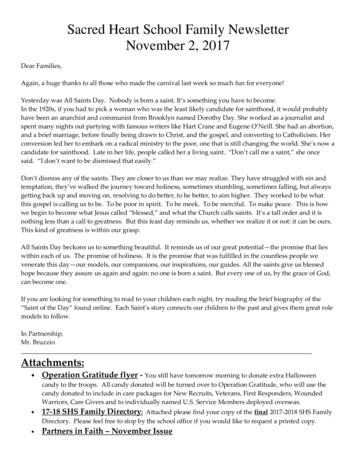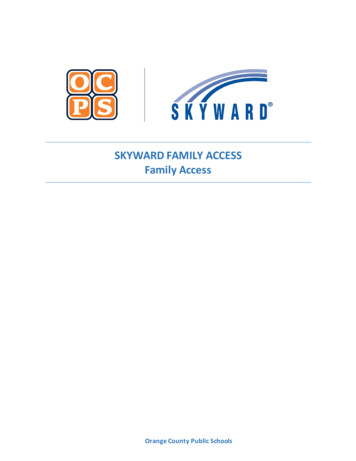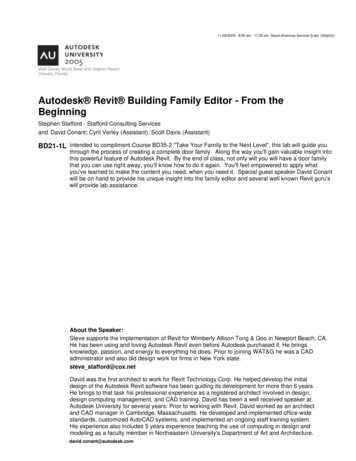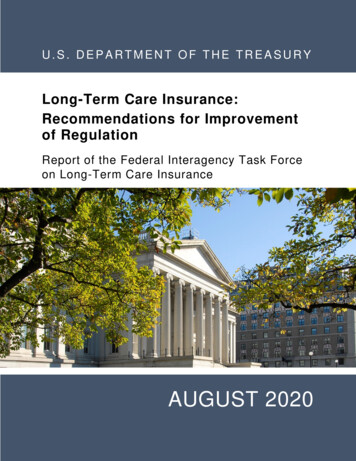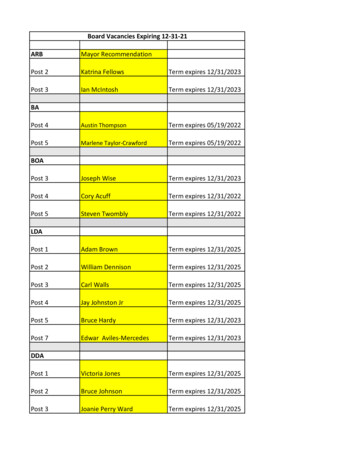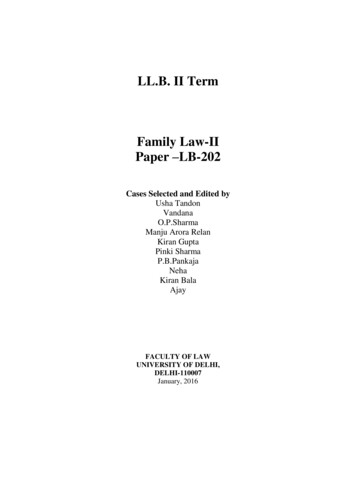
Transcription
LL.B. II TermFamily Law-IIPaper –LB-202Cases Selected and Edited byUsha TandonVandanaO.P.SharmaManju Arora RelanKiran GuptaPinki SharmaP.B.PankajaNehaKiran BalaAjayFACULTY OF LAWUNIVERSITY OF DELHI,DELHI-110007January, 2016
LL.B. II TermPaper – LB – 202 : Family Law – II(Hindu Law of Joint Family, Partition and Debts, Gifts and Wills, Muslim Lawof Gifts & Wills, Hindu Succession Act and Muslim General Principles of Inheritance)Hindu law has the most ancient pedigree of any known legal system. Where, not modified orabrogated by legislation, Hindu law may be described to be the ancient law of the Hindus rootedin the Vedas and enounced in the Smritis as explained and enlarged in recognized commentariesand digests and as supplemented and varied by approved usages. The concept of Hindu law isdeeply rooted in Hindu philosophy and Hindu religion. Till this day, no precise definition of theword ‘Hindu’ is available in any statute or judicial pronouncement; it has defied all efforts atdefinition. There are two main schools of Hindu law; viz. the Mitakshara school and theDayabhaga school or Bengal school. They have emerged in the era of Digests and Commentaries.The codified Hindu Law lays down uniform law for all Hindus. In the codified areas of HinduLaw, there is no scope for existence of schools. The schools of Hindu law have relevance only inrespect of the un-codified areas of Hindu Law.Prescribed Legislation:The Hindu Succession Act, 1956 as amended by The Hindu Succession (Amendment) Act, 2005(No.39 of 2005)Prescribed Books:1. Ranganath Misra, Mayne’s Treatise on Hindu Law & Usage (16th ed., 2008)2. Satyajeet A. Desai, Mulla Principles of Hindu Law, Vol. I & II (21ST ed., 2010)3. Poonam Pradhan Saxena, Family Law Lectures, Family Law– II, (3rd ed., 2011)4. Paras Diwan and Peeyushi Diwan, Modern Hindu Law (20th ed., 2009)5. Duncan M. Derrett, A Critique of Modern Hindu Law (1970)6. M. Hidayatullah and Arshad Hidayatullah, Mulla, Principles of Mahomedan Law(19th ed., 1990)(reprint 2008)7. Asaf A.A. Fyzee, Outlines of Muhammadan Law (5th ed.2008)PART - A : HINDU LAW OF JOINT FAMILYTopic 1 : Joint Hindu Family and Hindu CoparcenaryThe Mitakshara joint family is a unique contribution of Hindu law which has no parallel in anyancient or modern system of law. Whatever the sceptic may say about the future of the Hindu jointfamily, it has been, and still continues to be, the fundamental aspect of life of Hindus. In Hindulaw, there is a presumption that every family is a joint Hindu family. The males in a joint Hindu
iiifamily up to four generations from the last holder of the property are known as coparceners andthey acquire a right by birth in the joint Hindu family property. This group of males is known ascoparcenary. Hindu Succession (Amendment) Act 2005, has Confers on daughter the same statusas that of a son as coparcener in Hindu joint family.Kinds and Sources of property: Coparcenary and separate property, Gift from paternal ancestorand property inherited from maternal ancestor.Karta -The position of karta in a joint Hindu family is sui-generis. Karta in a joint familyoccupies a very important position. His position is so unique that there is no office or institution inany other system of the world which is comparable with it. The Judicial Committee of the PrivyCouncil in Hunoomanpersaud Panday v. Mussumat Babooee Munraj Koonweree (1856) 6Moore’s I.A. 393 had discussed the extent of karta’s power in relation to joint Hindu familyproperty.(a) Concept of joint Hindu family and coparcenary under Mitakshara and Dayabhaga lawand their incidents.(b) Karta-(i) Position (ii) Power(c) Judicial and Legislative Trends- Position Before 2005(d) Daughter as a Coparcener – Position After 2005(e) Property in Hindu Law1.Commissioner of Income- Tax v. Gomedalli Lakshminarayan, AIR 1935 Bom. 412 012.Moro Vishwanath v. Ganesh Vithal (1873) 10 Bom. 444043.Muhammad Husain Khan v. Babu Kishva Nandan Sahai, AIR 1937 PC 233104.C.N. Arunachala Mudaliar v. C.A. Muruganatha Mudaliar, AIR 1953 SC 495135.Smt. Dipo v. Wassan Singh, AIR 1983 SC 846216.Commissioner of Wealth-Tax v. Chander Sen, AIR 1986 SC 1753237.M/s. Nopany Investments (P) Ltd. v. Santokh Singh (HUF),2007 (13) JT 448318.Mrs. Sujata Sharma v. Shri Manu Gupta 226 (2016) DLT 647Topic 2 : Alienation of Joint Hindu Family PropertyOrdinarily, neither karta nor any other coparcener singly possesses full power of alienation overthe joint family property or over his interest in the joint family property. It is now settled that kartacan alienate the joint Hindu family property in exceptional circumstances, i.e. legal necessity andbenefit of estate.(a) Alienation by karta - sale, mortgage, gifts and wills(b) Alienation by father(c) Alienee’s rights duties and remedies(d) Pious obligations of the son8.9.10.11.12.Hunoomanpersaud Panday v. Mussumat Babooee Munraj Koonweree(1854-1857) 6 Moore’s IA 393 (PC) 36Sunil Kumar v. Ram Prakash (1988) 2 SCC 77Dev Kishan v. Ram Kishan, AIR 2002 Raj. 370Balmukand v. Kamla Wati, AIR 1964 SC 1385Guramma Bhratar Chanbasappa Deshmukh v. Mallappa Chanbasappa,3651606974
13.14.AIR 1964 SC 510R. Kuppayee v. Raja Gounder (2004) 1 SCC 295Arvind & Abasaheb Ganesh Kulkarni v. Anna & Dhanpal Parisa Chougule,AIR 1980 SC 6458187Topic 3 : PartitionPartition means bringing the joint status to an end. On partition, the joint family ceases to be joint,and nuclear families or different joint families come into existence. There are members of the jointfamily who can ask for partition and are entitled to a share also. There is another category of themembers of the joint family who have no right to partition but, if partition takes place, they areentitled to share. A reunion can be made only between the parties to partition.(a) What is partition(b) Subject matter of partition(c) Partition how effected(d) Persons who have a right to claim partition and who are entitled to a share(e) Rules relating to division of property15.16.17.A. Raghavamma v. A. Chenchamma, AIR 1964 SC 136Puttrangamma v. M.S. Ranganna, AIR 1968 SC 1018Kakumanu Pedasubhayya v. Kakumanu Akkamma, AIR 1968 SC 10428999107PART - B : THE HINDU SUCCESSION ACT, 1956The law of inheritance comprises rules which govern devolution of property, on the death of aperson, upon other persons solely on account of their relationship to the former. The HinduSuccession Act came into force on 17 June 1956. It amends and codifies the law relating tointestate succession among Hindus and brings about some fundamental and radical changes in thelaw of succession. The Act lays down a uniform and comprehensive system of inheritance andapplies inter alia to persons governed by Mitakashara and Dayabhaga schools, as also to those incertain parts of southern India who were previously governed by the Murumakkattayam,Alyasanatana and Nambudri systems of Hindu law. The Act was last amended in 2005, and hasbrought in major changes in the classical concept of coparcenary as also in the class I heirs to theproperty of a male intestate.Topic 4: General Introduction and the Application of the Hindu Succession Act, 1956(a) General principles of inheritance(b) Disqualifications of heirs18. Vellikannu v. R. Singaperumal (2005) 6 SCC 62219 Nirmala v. Government of NCT of Delhi, 170(2010) DLT 57720 Revanasiddappa v. Mallikarjun, (2011) 11 SCC 121. Ganduri Koteshwaramma and another v. Chakiri Yanadi and another(2011) 9SCC 788115122132141
v2223.24.24.25.Prakash Vs. Phulavati, 2015 SCC Online SC 1114Topic 5 : Succession to the Property of Male Intestate(a) Mitakshara property(b) separate property148Gurupad Khandappa Magdum v. Hirabai Khandappa Magdum,AIR 1978 SC 1239Uttam v. Saubhag Singh (2016) 4 SCC 68Topic 6: Succession to the Property of Female Intestate156Bhagat Ram v. Teja Singh, AIR 2002 SC 1Omprakash v. Radhacharan, 2009(7) SCALE 51161164Topic 7 : Hindu Women’s estate26.27.Vaddeboyina Tulasamma v. Vaddeboyina Sesha Reddi, AIR 1977 SC 1944Jagannathan Pillai v. Kunjithapadam Pillai, AIR 1987 SC 1493Jupudy Pardha Sarathy v. Pentapati Rama Krishna (2016) 2 SCC 56167175PART – C : MUSLIM LAWTopic 8 : Law Relating to Gifts(a) Meaning and essentials of a valid gift(b) Gift of Mushaa(c) Gift made during Marz-ul-Maut28. Mussa Miya walad Mahammed Shaffi v. Kadar Bax, AIR 1928 PC 108 16029. Valia Peedikakkandi Katheessa Umma v. Pathakkalan Narayanath Kunhamu,AIR 1964 SCC 275 16530. Hayatuddin v. Abdul Gani, AIR 1976 Bom. 23 17131. Abdul Hafiz Beg v. Sahebbi, AIR 1975 Bom. 165 178182187193200Topic 9 : Law relating to Wills(a). Capacity to make Will(b). Subject matter of Will(c) To whom Will can be made(d). Abatement of legaciesTopic 10 : Law relating to Inheritance(a) General rules of inheritance of Sunnis and Shias(b) Classification of heirs(c) Entitlement of primary heirsIMPORTANT NOTE:1. The students are advised to read the books prescribed above along with Legislations and cases.2. The topics and cases given above are not exhaustive. The teachers teaching the course shall beat liberty to add new topics/cases.3. The students are required to study the legislations as amended up-to-date and consult the latesteditions of books.
law, there is a presumption that every family is a joint Hindu family. The males in a joint Hindu . iii family up to four generations from the last holder of the property are known as coparceners and they acquire a right by birth in the joint Hindu family property. This group of males is known as coparcenary. Hindu Succession (Amendment) Act 2005, has Confers on daughter the same status as .


